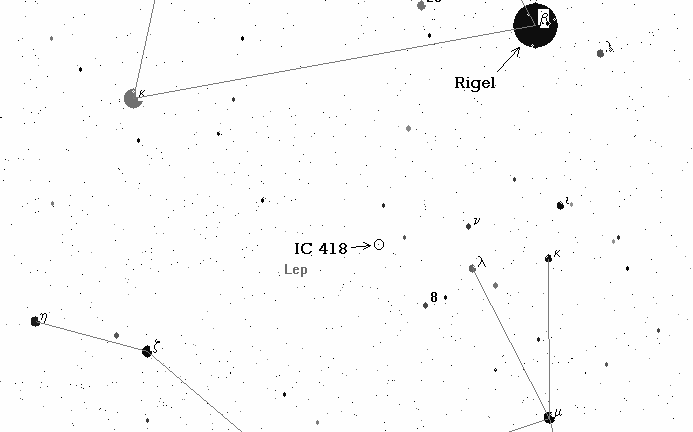IC 418: The "Raspberry" Nebula
Jack Kramer
The planetary nebula IC 418 is a unique object in Lepus, a constellation that many of us might tend to bypass in favor of its prominent neighbor to the north, Orion. In larger instruments, this nebula exhibits a reddish hue that has earned it the nickname "Raspberry Nebula". It has also become known as the "Spirograph Nebula", due to its appearance in the following HST image. Moreover, during observation this planetary exhibits a pronounced variability in brightness similar to that of the Blinking Nebula (NGC 6826) and the Eskimo Nebula (NGC 2392).

IC 418 has a fairly bright central star, which is listed at magnitude 10.17 in the Night Sky Observer's Guide and 11 in the Saguaro database; the nebula itself is listed at magnitude 10.7 in the Saguaro.
I originally observed IC 418 in 1994 from Libertyville with a 10-inch Newtonian. Due to local light pollution, I used the "blinking" trick - passing a narrowband nebula filter (OIII) in and out of the field once I was pretty sure that I was in the area of IC 418. My observing notes record that without the OIII filter, only the central star was visible. With the filter in place, the nebula showed up easily as a tiny circular spot, but then the star was no longer discernible since it was immersed in the enhanced glow of the nebula.
To digress for a moment, OIII filters are referred to as "line" filters because they pass a very narrow range of the visible spectrum, in this case, the line of doubly ionized oxygen. This makes them ideally suited for planetary nebulae, in which this element predominates. Other narrowband filters such as the Lumicon UHC and Orion UltraBlock pass a somewhat wider range of the visible spectrum, and are therefore useful for a larger number of nebulae, particularly diffuse emission nebulae. So if you will have only one narrowband filter, get a UHC or UltraBlock. Now back to IC 418...
One observer, Dave Mitsky, reported the following observations with relatively large scopes: "I observed IC 418 using the 17" classical Cassegrain at the ASH Naylor Observatory, which is located near Lewisberry, PA. I was pleasantly surprised to find that IC 418 presented a faint pink color. In the past I'd never detected any color in this DSO using either the 17" or a 20" classical Cassegrain belonging to a friend. (I was treated to seeing IC 418's remarkable hue for the first time at the 1995 WSP through Ed Boutwell's 25" Dob.) Magnifications used were 118, 144 (with and without an Orion UltraBlock filter), 202, 249, 259, and 404x with the pink being most noticeable at 202x. I can only surmise that the better than usual transparency and seeing at the time allowed me to perceive IC 418's pinkish shade and the blinking effect so easily. Speculation has it that with scopes larger than 20" or so in aperture the Raspberry Nebula's color is very easily detected."
The following chart is adapted from the Guide computer program.

The reproduction process here doesn't do justice to this gorgeous multicolored object as imaged by the Hubble. If you have Internet access, check out this article on our club web page, where a color image shows the Raspberry/Spirograph planetary in all its glory.





